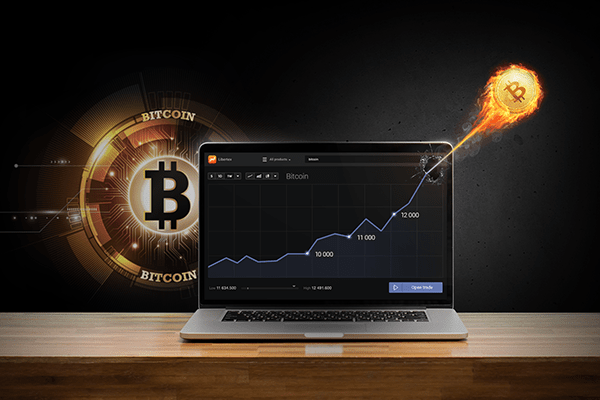Eduardo Strecht Ricou, Libertex Senior Analyst
I am often asked if I have a favourable or unfavourable opinion regarding the world of cryptocurrencies. I answer them with a question: “Do you know what Bitcoin is for?”
They sometimes answer that they’re “not sure” what Bitcoin is for, but that they heard the neighbour screaming out the window that he had made money buying and selling Bitcoin.
What is Bitcoin? A new revolution in the technological world
I am not referring to artificial intelligence or robots, but yes, to the world of cryptocurrencies. Everyone has heard a lot about this type of active crypto, the most famous being Bitcoin, as well as others like Ripple.
Bitcoin was created to make payments over the internet in a faster, safer and cheaper way, in addition to being a decentralized means of payment.
Blockchain is the basis of all cryptocurrencies. Without blockchain, Bitcoin would not exist
The subject is a bit technical. Blockchain is basically a global data book that contains all the reliable records, since all transactions are validated before a new block is composed. It is said to be so safe that it was even nicknamed “trust protocol”, that is to say, the reason for decentralization, in other words, that no one regulates or controls it. It is expandable, simply validating the data and records that are protected by advanced cryptography, not allowing the source data to be removed, revised or modified.
As it is a new technology, there is still much to explore and develop. The time of transactions must decrease. The validation of data, the lack of supervision and regulation can be seen as very libertarian, as well as a great danger, because users aren’t endorsed or protected by any corporation, public entity or state in the event that something bad happens, such as a hack.
Bitcoin mining involves the use of different equipment and media
The crypto miner has a complex job ahead. For Bitcoin mining, machines and computers with a high capacity are needed. Consequently, the energy cost to keep the machines running all the time in order to obtain tokens is very high.
To mine Bitcoin, we need computers like the ASIC, more commonly known as Antminers, which offer a fairly high TH/s rate compared to graphics cards (GPUs). The first problem is its very high acquisition price, with an average cost of around $2,000. It is clear that technological advances and new solutions will reduce the cost of acquisition in the future, forcing the manufacturers of these pieces of equipment to improve their machines every day. All this for important events such as the one we are facing with Bitcoin, the halving.
In a nutshell, the halving process is nothing more than halving the value of Bitcoin.
What is the meaning of the halving of the Bitcoin block?
Halving decreases the number of new Bitcoins generated per block. This means that the supply of new bitcoins is less.
In trade, lower supply with stable demand generally leads to higher prices. Since halving reduces the supply of new bitcoins, and demand generally remains stable, halving has generally preceded some of Bitcoin's biggest hikes. In 2012 and 2016, we had two halvings. The idea was developed to have programmed currency issuance and decrease over time, and that is why the cut in the miners’ reward is applied.
Halving has an impact on Bitcoin mining, and by cutting the reward for mined blocks in half, the profitability to maintain the equipment is affected due to the drop in miners’ income.
The processing power of the Bitcoin network will undoubtedly increase with the halving event and the arrival of new miners on the market, equipped with chips that can provide greater power and efficiency. This is something that we will see more frequently after 12 May, next halving date.
There is a hypothesis that miners and mining groups will disconnect their equipment due to the losses that the halving event would cause. However, as we already mentioned, this cut in the issuance of coins could cause a price increase, such that it manages to balance economic calculations. However, there is a fair bit of doubt about how long it will take for the Bitcoin price to rise.
Therefore, since I don’t consider Bitcoin to be an asset, I also don’t need to consider the traditional and common currency that allows me to buy a coffee in the morning, without having to worry about the sudden change in value in relation to the US dollar.

Bitcoin is more than everything in its romantic essence: a decentralized, fast and secure digital payment method accessible to everyone
As I explained above, the cost of the miner can be very high. Therefore, the commissions as a percentage of the value of Bitcoin is what will create the solution to trade in the unregulated system of Bitcoin, so that miners are rewarded for their crypto services. With the cost of energy entering the equation, it is necessary to have the equipment in continuous operation.
According to a study carried out by the Dutch bank ING, 211 kWh are consumed to validate a BTC transaction. Said consumption has the capacity to supply a home for one month; hence, the electric bills of those who mine BTC are very high.
So, if the miner keeps half of his Bitcoin in the halving, with the high energy costs and the maintenance of his machines for the processing of Tokens, only the miner will survive if the price of Bitcoin rises and rebalances the mining cost; although today you can mine Bitcoin in Cloud Mining. This allows you to execute the extraction process without requiring the use of so many resources. Cloud mining is simpler: with a home computer and internet, we can connect to the cloud and process the algorithms remotely without the need for a machine (hardware), since it is a third party that supplies the machine to us. But alas, it is not profitable, even if it the energy costs are reduced for the machines.
Traders and investors therefore have the opportunity to buy and sell Bitcoin, but be aware that the idea of listing Bitcoin greatly undermines its initial concept, the introduction of many speculators and the absence of more consistent news in the crypto world, brings a lot of noise and volatility to the cryptocurrency markets, removing the stability factor that is so necessary to a global currency for the exchange of goods and services on the planet.
After the crypto fever in 2018, we witnessed a correlation between Bitcoin and gold, from April to November 2019. The theory was that Bitcoin is just like gold. It does not have any yield or interest rates, and is used by large investors as an instrument for diversifying portfolios by risky assets. Some analysts have come to place Bitcoin as a protection instrument against turbulence in the financial markets.
What really happened in these last four months leads me to the conclusion that there is no correlation with gold, or with anything, for the simple reason that it is a digital currency, and what drives the price is more than just the news: if the Libra project goes ahead on Facebook and Bitcoin is dethroned. After the quarantine period, globalization will slow its pulse; will we return to regional and local trade? This would not be very positive for Bitcoin. The new needs created by the virus are increasingly launching us into the digital world. Will this be positive for Bitcoin?
There are some issues we may have to tackle in the uncertain months coming up ahead of us, as well as new solutions and inventions or opportunities.
But beware, Bitcoin is not the dollar, nor will it be in the coming years, and there are three reasons for this
The first: to relaunch the economy, the states and central banks must continue on a path of expansion and growth, and that implies the issuance of money, a lot of money.
The second reason is that in these last few months, the dollar was highly effective in solving merchandise payments with the planet practically all locked up at home.
The third reason is the very high volatility, although after the collapse in early March, Bitcoin managed to recover up to $7,500. That being said, I don’t see it taking off like gold. Seeing the dollar, by measurement of the dollar index (basket of six currencies against the dollar), with a very stable trend and reduced volatility, is more than essential in times of great turbulence in the financial markets, and when facing total uncertainty of the near future.
In short, I believe in the concept as an investor, it is very attractive for the future, but there are risks of price volatility, of being new, of being dethroned by the Facebook Libra, or of not being accepted and used on a large scale for the payment of goods and services. For the traders, it is very important to follow up on the news that has a great impact on the price of Bitcoin, just as the analysis of graphics helped us understand how the public reacted to Bitcoin at certain moments in the market.
Don’t miss the chance to buy Bitcoin now before the halving with Libertex.






